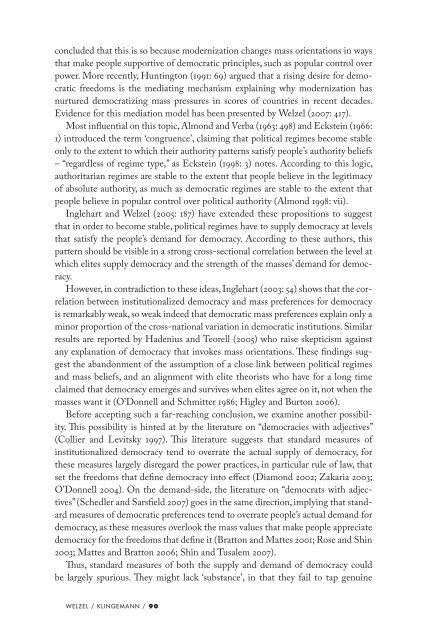download - UvA DARE
download - UvA DARE
download - UvA DARE
You also want an ePaper? Increase the reach of your titles
YUMPU automatically turns print PDFs into web optimized ePapers that Google loves.
concluded that this is so because modernization changes mass orientations in ways<br />
that make people supportive of democratic principles, such as popular control over<br />
power. More recently, Huntington (1991: 69) argued that a rising desire for democratic<br />
freedoms is the mediating mechanism explaining why modernization has<br />
nurtured democratizing mass pressures in scores of countries in recent decades.<br />
Evidence for this mediation model has been presented by Welzel (2007: 417).<br />
Most influential on this topic, Almond and Verba (1963: 498) and Eckstein (1966:<br />
1) introduced the term ‘congruence’, claiming that political regimes become stable<br />
only to the extent to which their authority patterns satisfy people’s authority beliefs<br />
– “regardless of regime type,” as Eckstein (1998: 3) notes. According to this logic,<br />
authoritarian regimes are stable to the extent that people believe in the legitimacy<br />
of absolute authority, as much as democratic regimes are stable to the extent that<br />
people believe in popular control over political authority (Almond 1998: vii).<br />
Inglehart and Welzel (2005: 187) have extended these propositions to suggest<br />
that in order to become stable, political regimes have to supply democracy at levels<br />
that satisfy the people’s demand for democracy. According to these authors, this<br />
pattern should be visible in a strong cross-sectional correlation between the level at<br />
which elites supply democracy and the strength of the masses’ demand for democracy.<br />
However, in contradiction to these ideas, Inglehart (2003: 54) shows that the correlation<br />
between institutionalized democracy and mass preferences for democracy<br />
is remarkably weak, so weak indeed that democratic mass preferences explain only a<br />
minor proportion of the cross-national variation in democratic institutions. Similar<br />
results are reported by Hadenius and Teorell (2005) who raise skepticism against<br />
any explanation of democracy that invokes mass orientations. These findings suggest<br />
the abandonment of the assumption of a close link between political regimes<br />
and mass beliefs, and an alignment with elite theorists who have for a long time<br />
claimed that democracy emerges and survives when elites agree on it, not when the<br />
masses want it (O’Donnell and Schmitter 1986; Higley and Burton 2006).<br />
Before accepting such a far-reaching conclusion, we examine another possibility.<br />
This possibility is hinted at by the literature on “democracies with adjectives”<br />
(Collier and Levitsky 1997). This literature suggests that standard measures of<br />
institutionalized democracy tend to overrate the actual supply of democracy, for<br />
these measures largely disregard the power practices, in particular rule of law, that<br />
set the freedoms that define democracy into effect (Diamond 2002; Zakaria 2003;<br />
O’Donnell 2004). On the demand-side, the literature on “democrats with adjectives”<br />
(Schedler and Sarsfield 2007) goes in the same direction, implying that standard<br />
measures of democratic preferences tend to overrate people’s actual demand for<br />
democracy, as these measures overlook the mass values that make people appreciate<br />
democracy for the freedoms that define it (Bratton and Mattes 2001; Rose and Shin<br />
2003; Mattes and Bratton 2006; Shin and Tusalem 2007).<br />
Thus, standard measures of both the supply and demand of democracy could<br />
be largely spurious. They might lack ‘substance’, in that they fail to tap genuine<br />
Welzel / klIngemAnn / 90
















